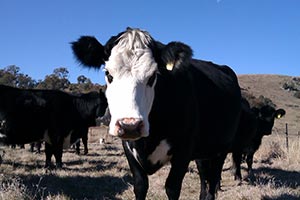Livestock management

On this page:
Important – If you keep livestock in the ACT, even if it is only one animal, you must have a Property Identification Code (PIC) for the location where the animal is held.
National Livestock Identification System (NLIS)
The National Livestock Identification System (NLIS) is an Australia-wide system that is used to identify and trace cattle, sheep, goats and pigs (through the PigPass database).
The NLIS ensures that Australia's export market access and food safety assurances are of the highest standard.
It also assists in the event of an emergency animal disease outbreak by enabling the rapid tracing of livestock movements and identifying the potential spread pattern of the disease.
The NLIS is based on 3 elements:
- Livestock are identified by a permanent identifier, either a visual or electronic tag.
- Identification of the physical location of the animal using a Property Identification Code (PIC).
- Livestock location data and movements are recorded in a central database.
All cattle, sheep and goats must:
- be identified with an approved NLIS tag
- be held on a property with a PIC
- have their movements to sale, slaughter or to any other property recorded in the NLIS database.
Compliance with NLIS requirements in the ACT is mandatory. Failing to adhere to these requirements puts at risk Australia’s livestock industries and significant penalties may apply.
For more information about NLIS:
- visit Integrity Systems
- phone 02 6207 2357 (for ACT livestock owners).
Property Identification Code (PIC)
Property Identification Codes (PIC) are an important part of the NLIS and:
- help in the identification and tracing of stock movements
- assist in the identification of properties that may be impacted during an animal disease emergency.
You must have a PIC is you have the following livestock at your property:
- cattle, including bison and buffalo
- pigs
- goats
- sheep
- camels, alpacas and llamas
- deer
- horses, donkeys, asses, mules and zebras
- 100 or more chickens, turkeys, guinea fowl, ducks, geese, quails, pigeons, pheasants and partridges
- 10 or more emus or ostriches.
A PIC is required for all livestock including pets and livestock held on an urban property. Penalties may apply for failing to obtain a PIC.
A PIC is required when ordering NLIS-accredited identification devices, for National Vendor Declarations (NVDs) and general stock movement identification.
To apply for or amend your contact details for a PIC complete an application.
For further information on PICs located in the ACT call 02 6205 3737.
Sheep and Goat Individual Electronic Identification (eID)
In September 2022, all agricultural ministers in Australia agreed to work towards mandatory implementation of electronic identification for sheep and goat nation-wide by 1 January 2025.
The ACT Government is aligning the ACT implementation plan with NSW to ensure ACT farmers will meet the mandatory requirements of NSW saleyards and processors.
The ACT timeline for implementation:
1 January 2025
- Mandatory eID for all sheep and farmed goats born from this date, prior to leaving property of birth
- Mandatory eID property to property transfers
1 January 2027
- Mandatory eID for all sheep and farmed goats prior to leaving any property
Read more about sheep and goat eID on the NSW Department of Primary Industries Sheep and Goat Individual Electronic Identification webpage.
National Vendor Declarations (NVD)
National Vendor Declarations (NVD) communicate the food safety and treatment status of every animal every time it moves between properties, to saleyards or processors. NVDs are a legal document.
To access NVDs, you need to:
- Have a PIC
- Be accredited with Livestock Production Assurance (LPA).
Once LPA accredited you will be able to access NVDs and eNVDs.
For more information:
- visit Integrity Systems
- phone 1800 683 111
- email info@integritysystems.com.au.
Animal welfare when transporting livestock
The Australian Animal Welfare Standards and Guidelines – Land Transport of Livestock have been implemented in the ACT as the Animal Welfare (Land Transport of Livestock) Mandatory Code of Practice 2018 (No 1).
During the transport of livestock the ‘person in charge’ of the animals changes at different points of the journey and will include the producer, the transporter and the receiver (agent, saleyard, processor).
The person in charge of the animal(s) at each point are responsible for the animals welfare, including reducing the risks to their welfare
An animal must be assessed as ‘fit to load’ before transporting. Read more about how to decide if an animal is fit to be loaded for transport on the Meat and Livestock Australia (MLA) website – Is the animal fit to load? If in doubt, leave it (the animal) out!

